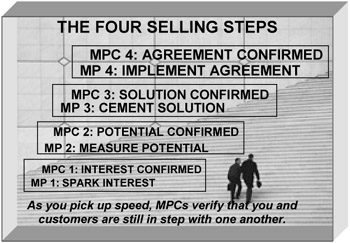How MeasureMax Works
The MeasureMax selling system is 90 percent planning and 10 percent doing. Therefore, it starts with your Product and Market Profile sheets. These sheets highlight which groups of customers share goals that connect to your unique strengths or strongest features. You then plan where you want to invest your selling efforts. The ability to sell value and to receive compensation for doing so depends on whom you contact.
MeasureMax is also about measurability. Like you, customers know they can only manage what they can measure. They eagerly wait for you to help them quantify their goals and filters. You motivate customers to rethink their purchasing decisions in terms of the quality and value of their goals, not just the quantity and price of products' features. It is difficult to dispute that it makes good business sense to measure twice, cut once, before you decide what to buy or sell. MeasureMax's format ensures that you are ready to evaluate sales opportunities as a marketing manager, competitor, sales manager, salesperson, and most important, customer.
Now, it is just a question of how you do it.
The four selling phases called Measurable Phases (MPs) (see pages 7 and 8 in the Introduction) are the how-to part. They break sales opportunities into four minisales in which customers give you a kind of "purchase order'' to end each phase. These are not your typical purchase orders (except for the last one). Instead, they are measurable commitments, or Measurable Phase Changes (MPCs), you receive from customers that confirm it still makes sense to continue trying to achieve their goals. Each MPC brings you closer to receiving the fourth MPC (Agreement Confirmed), which is your typical purchase order. Receiving MPCs renders the purchase order as nothing more than the logical conclusion to a series of customer commitments.
You also use MPCs to gauge your progress. These sales mile-stones denote that you have completed one MP and are ready to start the next one. The faster you obtain MPCs in the right sequence, the faster you receive orders. Needing fewer in-person sales calls to get more orders is how you make productivity boom.
You will also see how the sequence of the MPCs affects your ability to sell value. If you receive MPC 1 to 4 in order you build value; if you go out of order, you diminish value. In addition, a failure to obtain an MPC means customers are not ready to go to the next MP. Chapter 8 explains how to handle these situations.
| Note | Two case studies spanning this chapter and Chapters 7 and 8 demonstrate how MPs and MPCs work with new prospects. Chapter 9 explains how to use them with existing customers. The first case study (which continues with Steven Smartsell) examines the steps conceptually in a business-to-business sale. At the end of these chapters, another case study takes a business-to-consumer sale from inception to conclusion. It details the steps and logistics of the four phases. (See Exhibit 6-1.) |
| Note | There are no submissive roles in this sales process. (Leave those for the needs-satisfaction type of salespeople). You and customers are equal partners who take turns leading in the four selling phases. In the first two, customers lead with their goals, filters, measurable benefits, and systems of evaluations (SOEs). In the last two, you lead with your unique strengths, features, and measurable benefits. In Chapter 7, you will see how the common measurable benefits connect goals to features. |
EAN: 2147483647
Pages: 170
